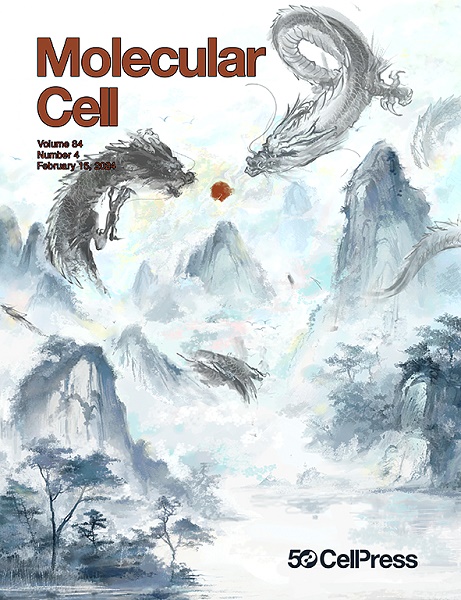核小体指定辅助因子进入p53
IF 14.5
1区 生物学
Q1 BIOCHEMISTRY & MOLECULAR BIOLOGY
引用次数: 0
摘要
先锋转录因子(tf)参与染色化的DNA基序。然而,目前尚不清楚tf -核小体复合物是如何被辅助因子解码的。在人类中,TF p53调节细胞周期进程、细胞凋亡和DNA损伤反应,大部分p53结合位点位于核小体携带不可接近的染色质中。我们研究了染色质结合的p53与泛素蛋白酶体系统(UPS)的辅助因子的相互作用。在核小体上的两个不同基序位置(超螺旋位置[SHL]−5.7和SHL+5.9), E3泛素连接酶E6-E6AP无法结合核小体参与的p53。另一方面,去泛素酶USP7在体外和细胞中很容易与核小体结合的p53结合。相应的冷冻电镜(cryo-EM)结构显示USP7与p53和核小体结合。我们的工作说明了染色质如何对p53相互作用物施加辅助因子选择屏障,从而灵活地束缚辅助因子和tf的相互作用域来控制辅助因子、tf和染色质之间的兼容性。本文章由计算机程序翻译,如有差异,请以英文原文为准。

Nucleosomes specify co-factor access to p53
Pioneer transcription factors (TFs) engage chromatinized DNA motifs. However, it is unclear how the resultant TF-nucleosome complexes are decoded by co-factors. In humans, the TF p53 regulates cell-cycle progression, apoptosis, and the DNA damage response, with a large fraction of p53-bound sites residing in nucleosome-harboring inaccessible chromatin. We examined the interaction of chromatin-bound p53 with co-factors belonging to the ubiquitin proteasome system (UPS). At two distinct motif locations on the nucleosome (super-helical location [SHL]−5.7 and SHL+5.9), the E3 ubiquitin ligase E6-E6AP was unable to bind nucleosome-engaged p53. The deubiquitinase USP7, on the other hand, readily engages nucleosome-bound p53 in vitro and in cells. A corresponding cryo-electron microscopy (cryo-EM) structure shows USP7 engaged with p53 and nucleosomes. Our work illustrates how chromatin imposes a co-factor-selective barrier for p53 interactors, whereby flexibly tethered interaction domains of co-factors and TFs govern compatibility between co-factors, TFs, and chromatin.
求助全文
通过发布文献求助,成功后即可免费获取论文全文。
去求助
来源期刊

Molecular Cell
生物-生化与分子生物学
CiteScore
26.00
自引率
3.80%
发文量
389
审稿时长
1 months
期刊介绍:
Molecular Cell is a companion to Cell, the leading journal of biology and the highest-impact journal in the world. Launched in December 1997 and published monthly. Molecular Cell is dedicated to publishing cutting-edge research in molecular biology, focusing on fundamental cellular processes. The journal encompasses a wide range of topics, including DNA replication, recombination, and repair; Chromatin biology and genome organization; Transcription; RNA processing and decay; Non-coding RNA function; Translation; Protein folding, modification, and quality control; Signal transduction pathways; Cell cycle and checkpoints; Cell death; Autophagy; Metabolism.
 求助内容:
求助内容: 应助结果提醒方式:
应助结果提醒方式:


